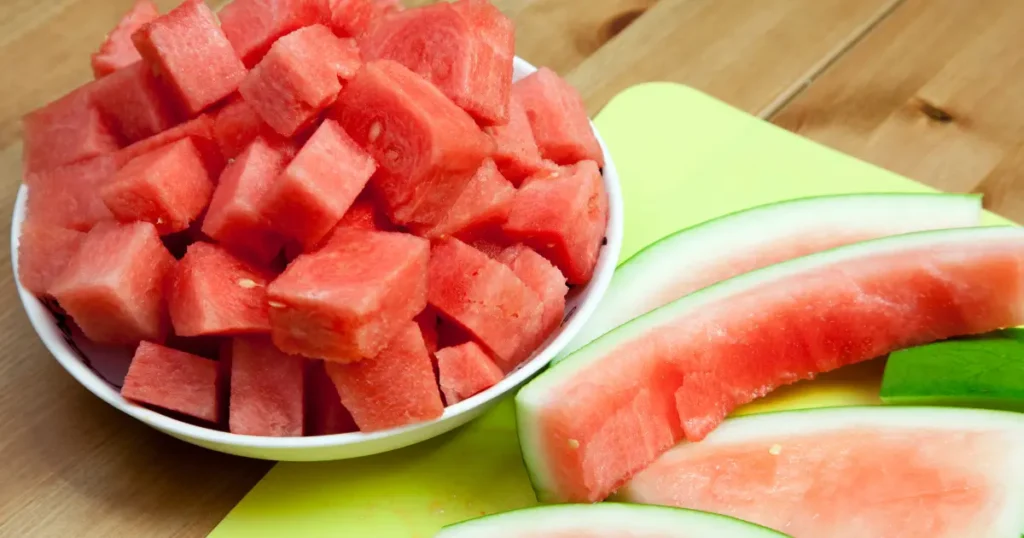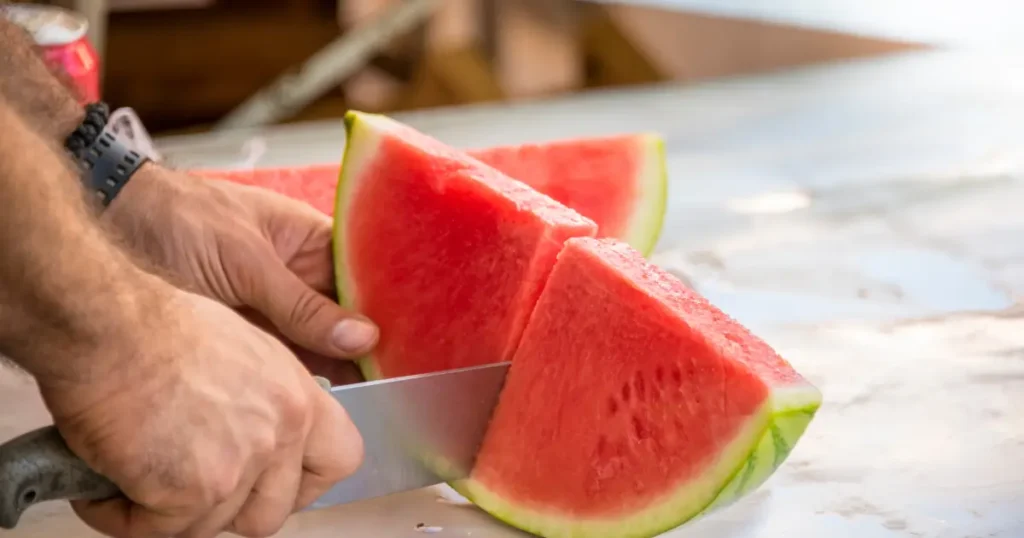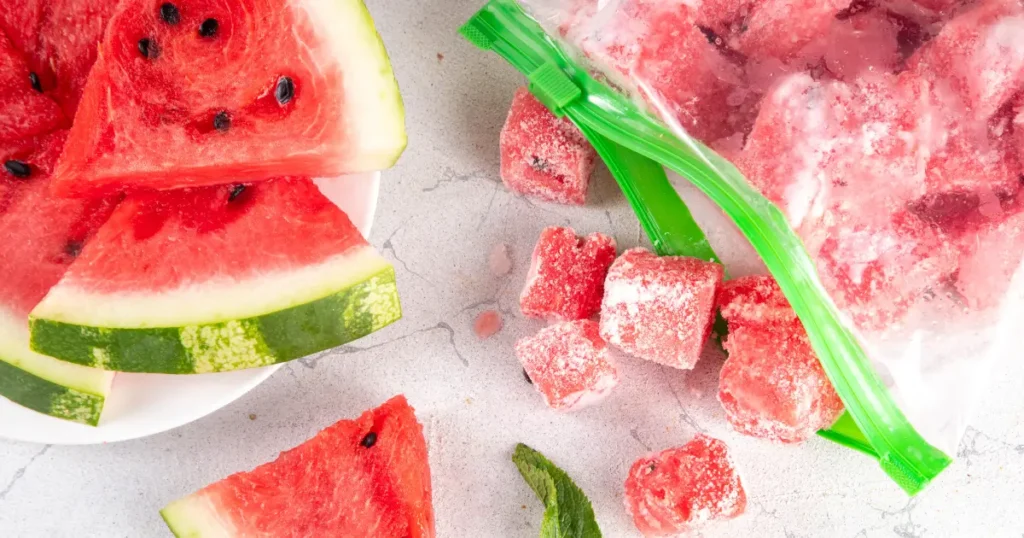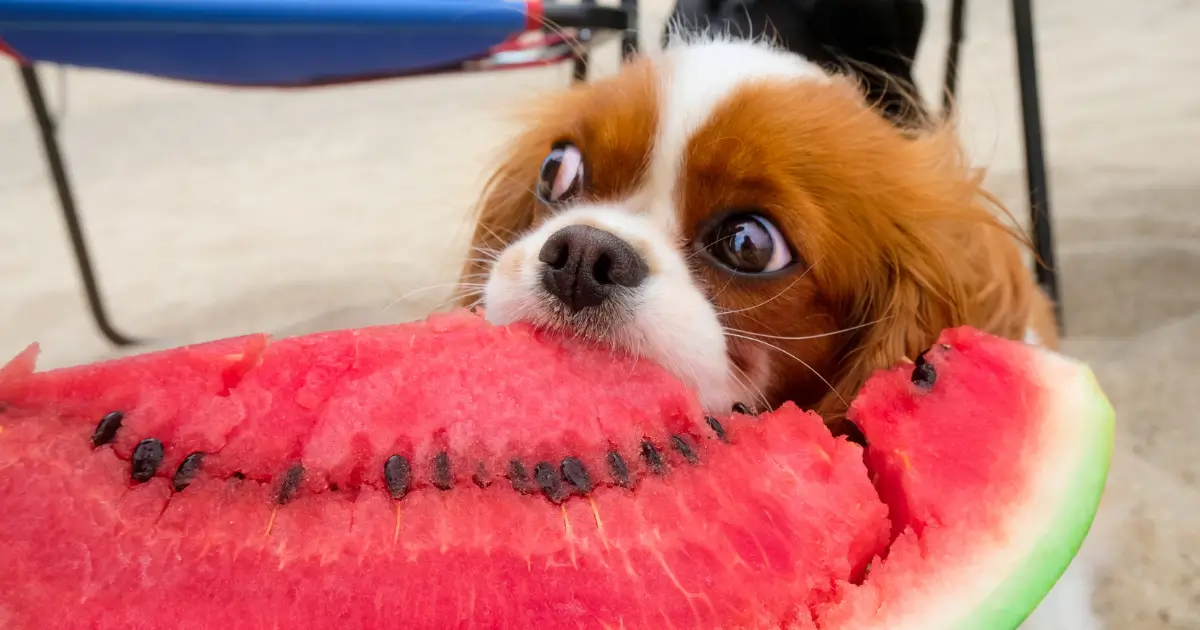Can Dogs Eat Watermelon Rind? 7 Safety Guidelines + Risks
Quick Answer: Can Dogs Eat Watermelon Rind?
Can dogs eat watermelon rind? No, dogs should not eat watermelon rind. Here’s why:
Immediate Dangers:
- Choking hazard – tough, fibrous texture
- Intestinal blockage – difficult to digest
- Digestive upset – vomiting, diarrhea, constipation
Why It’s Dangerous:
- Rind is too tough for dogs to break down properly
- Can cause serious gastrointestinal obstruction
- May contain pesticides or chemicals
Safe Alternative: Remove all rind and feed only seedless watermelon flesh in small amounts.
Emergency: If your dog ate watermelon rind, monitor for vomiting, difficulty breathing, or lethargy, and contact your vet immediately.
“Can dogs eat watermelon rind?” is a question that many dog owners have. while enjoying this refreshing summer fruit with their pets. While the juicy red flesh of watermelon is generally safe and healthy for dogs in moderation, the rind and peel require more careful consideration. This comprehensive guide will help you understand whether watermelon rind is appropriate for your canine companion and how to serve it safely if you choose to do so.
Table of Contents
What Happens If Dogs Eat Watermelon Rind? (Emergency Guide)
When people ask, “Can dogs eat watermelon rind safely?” the answer is always no. Here’s what can happen:
Immediate Symptoms to Watch For:
- Choking or gagging, especially in small dogs
- Vomiting or retching – the body trying to expel the rind
- Difficulty breathing – if rind blocks the airway
- Excessive drooling – a sign of distress
What to Do If Your Dog Ate Watermelon Rind:
- Monitor closely for 24-48 hours
- Contact your vet if any symptoms appear
- Never induce vomiting unless instructed by a vet
- Keep the dog hydrated, but limit food temporarily
Prevention is key: Always remove the rind completely before offering watermelon to dogs.
Understanding Watermelon Anatomy
Before addressing whether can dogs eat watermelon rind safely, it’s important to distinguish between the different parts of the watermelon:

- Red flesh: The sweet, juicy part that humans typically consume
- Rind: The white or light green firm layer between the red flesh and outer skin
- Peel: The watermelon’s hard, green outer layer
When dog owners ask, “Can dogs eat watermelon peel?” they’re usually referring to this outer green skin, which differs from the white rind portion. Let’s explore both components and their safety for canine consumption.
Can Dogs Eat Watermelon Rind? 7 Essential Facts
Here are seven critical facts every dog owner should know about feeding watermelon rind to their pets:
1. Watermelon Rind Is Not Toxic to Dogs
The good news is that watermelon rind does not contain toxic compounds that would poison your dog. Unlike certain foods like chocolate, grapes, or xylitol that are toxic to canines, watermelon rind does not contain substances that would cause immediate harm through toxicity.
However, just because can dogs eat watermelon rinds without toxic effects doesn’t mean it’s entirely without risk. Safety concerns relate more to digestibility and potential physical complications rather than chemical toxicity.
2. Digestibility Is a Major Concern
When considering can dogs eat watermelon rind, digestibility is the primary issue. The white rind is significantly firmer and more fibrous than the red flesh, making it:
- Harder for dogs to chew properly
- More difficult to digest
- Potentially irritating to the digestive tract
- A possible cause of gastrointestinal upset
Dogs with sensitive stomachs or those not accustomed to high-fiber foods may experience discomfort, gas, or loose stools after consuming watermelon rind.
3. Choking and Blockage Risks Exist
The firm texture of watermelon rind creates potential physical hazards, especially if your dog tends to gulp food without thorough chewing. Risks include:
- Choking: Large pieces can become lodged in the throat
- Intestinal blockage: Chunks of rind may cause obstructions in the digestive tract
- Impaction: Accumulated rind could lead to fecal impaction
These risks are even more significant when asking can dogs eat watermelon peel (the green outer skin), as this part is tougher and even less digestible than the white rind.
4. Nutritional Benefits Are Present But Limited
Watermelon rind does contain some beneficial nutrients, including:
- Citrulline: An amino acid that supports heart health and circulation
- Fiber: Supports digestive regularity when properly prepared
- Potassium: Essential for proper muscle and nerve function
- Vitamin A: Supports vision and immune function
- Vitamin C: Acts as an antioxidant
However, these health benefits of watermelon for dogs can largely be obtained from the flesh itself, which is easier to digest and safer to consume.
5. Proper Preparation Is Essential

When you weigh the advantages and disadvantages of giving your dog watermelon rind, it’s important to be prepared:
- Thoroughly wash the exterior to remove any pesticides or contaminants
- Remove all of the green outer peel (dogs should not eat watermelon peel)
- Depending on the size of your dog, cut the white rind into tiny pieces.
- Cook the rind to soften it and make it more digestible (steaming works well)
- Introduce slowly in small doses to check tolerance.
Without proper preparation, the already significant risks of digestive upset and obstruction increase substantially.
6. Moderation Is Critical
Even with proper preparation, moderation is essential when feeding watermelon rind to dogs. Here are some guidelines based on dog size:
| Dog Size | Maximum Rind Serving | Frequency |
|---|---|---|
| Small (under 20 lbs) | 1 teaspoon of prepared rind | Occasional treat only |
| Medium (20-50 lbs) | 1 tablespoon of prepared rind | Occasional treat only |
| Large (over 50 lbs) | 2 tablespoons of prepared rind | Occasional treat only |
Remember that “occasional” means once a week at most, and for many dogs, especially those with sensitive digestion, watermelon rind may not be appropriate at all.
7. Better Alternatives Exist
When considering can dogs eat watermelon rind, it’s worth noting that several safer, more digestible alternatives provide similar or superior nutritional benefits:
- Watermelon flesh (without seeds): Hydrating, nutritious, and easier to digest
- Frozen watermelon for dogs: Makes a refreshing summer treat without the digestibility issues
- Other dog-safe fruits: Blueberries, strawberries, apple slices (without seeds), and pears (without seeds) are excellent options
- Commercial dog treats: Formulated specifically for canine nutritional needs and safety
These substitutes can give dogs the health advantages of watermelon without the dangers of the rind.
Can Dogs Eat Watermelon Peel?
While we’ve primarily discussed the white rind, it’s important to address the green outer peel specifically. Can dogs eat watermelon peel safely? The answer is a more definitive no.
The green outer peel of watermelon:
- It is extremely tough and difficult to chew
- Presents a significant choking hazard
- It is very difficult to digest
- Has an increased risk of causing intestinal blockage
- Offers minimal nutritional benefit
- May contain pesticide residues (if not organic and thoroughly washed)
There is virtually no benefit to feeding watermelon peel to dogs, and the risks significantly outweigh any potential advantages. Unlike the white rind, which might be offered with careful preparation in very small amounts, the green peel should be completely avoided.
Safe Ways to Share Watermelon with Your Dog
Instead of risking the potential complications of watermelon rind or peel, consider these safer ways to share this refreshing fruit with your canine companion:
Fresh Watermelon Flesh
The safest way to share watermelon with your dog is to offer small pieces of the red flesh with seeds and rind removed. This provides:
- Hydration (watermelon is about 92% water)
- Natural sweetness without added sugars
- Vitamins A, B6, and C
- Potassium and other minerals
- A low-calorie treat option
To avoid choking, cut the meat into bite-sized pieces that are suitable for your dog’s size.
For dogs with dental issues, soft options like unsweetened applesauce or pureed watermelon can be easier to consume than firmer fruits.
Unlike citrus fruits such as mandarins, which contain acids that may upset some dogs’ stomachs, watermelon flesh is gentle and hydrating
Frozen Watermelon for Dogs

During hot summer months, frozen watermelon can be especially refreshing and beneficial:
- Offers cooling hydration
- Provides longer-lasting enjoyment
- Can soothe teething puppies
- Makes a fun enrichment activity
Simply freeze seedless watermelon chunks on a baking sheet, then transfer to a container for storage. Offer as an occasional cool treat, particularly after exercise or on hot days.
Pureed Watermelon
For senior dogs or those with dental issues, pureed watermelon can be:
- Easier to consume
- Mixed with regular food as a special topper
- Frozen in ice cube trays for portioned treats
- Added to homemade frozen treats with other dog-safe ingredients
Always ensure seeds are completely removed before pureeing.
Watermelon and Yogurt Frozen Treats
For a protein-rich frozen treat, mix plain, unsweetened yogurt with seedless watermelon puree. This combination offers:
- Probiotics from the yogurt
- Extended frozen texture
- Additional nutritional benefits
- A more substantial treat option
To make portioning simple, freeze in silicone molds or ice cube trays.
Symptoms to Watch For After Feeding Watermelon Rind
If you’ve decided to offer small amounts of prepared watermelon rind to your dog, monitor closely for these potential symptoms of digestive upset or obstruction:
- Vomiting: Especially if repeated or containing pieces of undigested rind
- Diarrhea: May indicate digestive irritation
- Constipation: Could signal a developing blockage
- Lethargy: Unusual tiredness may indicate discomfort
- Loss of appetite: Refusal to eat regular meals after consuming the rind
- Abdominal pain: Whining, hunched posture, or sensitivity when touched
- Straining during defecation May indicate difficulty passing stool
If any of these symptoms occur, discontinue offering watermelon rind immediately and consult your veterinarian, especially if symptoms persist or worsen.
Dogs That Should Avoid Watermelon Rind Completely
For some dogs, even properly prepared watermelon rind presents too great a risk. These include:
- Dogs with sensitive digestive systems: Those prone to upset stomachs or diarrhea
- Dogs with previous GI blockages: Those with a history of intestinal obstructions
- Puppies: Their developing digestive systems are more vulnerable
- Senior dogs may have more difficulty digesting tough fibers
- Small-breed dogs are at higher risk for blockages due to smaller digestive tracts
- Dogs with dental issues may struggle to chew the rind properly
- Dogs with pancreatic issues: The fiber could potentially trigger problems
For these dogs, stick to small amounts of the flesh only, avoiding both the rind and peel entirely.
Health Benefits of Watermelon for Dogs
While we’ve established that watermelon rind comes with significant cautions, it’s worth highlighting the genuine health benefits of watermelon flesh for dogs:
Hydration Support
With approximately 92% water content, watermelon flesh is excellent for:
- Supporting hydration during hot weather
- Encouraging fluid intake for dogs that don’t drink enough water
- Providing moisture with minimal calories
- Helping active dogs replenish fluids
This high water content makes watermelon particularly valuable during summer months when dogs are at increased risk of dehydration.
Unlike tropical fruits like papaya that offer digestive enzymes, watermelon’s benefits come primarily from its high water content and vitamins.
Vitamin and Mineral Content
Watermelon flesh provides several beneficial nutrients:
- Vitamin A: Supports vision and immune function
- Vitamin B6: Assists with brain function and metabolism
- Vitamin C: Acts as an antioxidant, supporting overall health
- Potassium: Essential for proper muscle and nerve function
- Magnesium: Supports energy production and bone health
These nutrients contribute to your dog’s overall health when watermelon is offered as an occasional treat.
Lycopene
The red color of watermelon comes from lycopene, a powerful antioxidant that:
- Helps combat oxidative stress
- Supports cardiovascular health
- May have anti-inflammatory properties
- Contributes to cellular health
This beneficial compound is concentrated in the red flesh, not the rind or peel.
Low in Calories
For dogs watching their weight, watermelon flesh offers:
- Sweet flavor with relatively few calories
- High water content creates a feeling of fullness
- A satisfying treat with minimal impact on daily caloric intake
- An alternative to higher-calorie commercial treats
This makes watermelon flesh a good option for dogs on weight management plans when offered in moderation.
Comparing Watermelon Parts: Safety and Benefits
To summarize the differences between watermelon parts for dogs:
| Watermelon Part | Safety Level | Benefits | Risks | Recommendation |
|---|---|---|---|---|
| Red Flesh (no seeds) | High | Hydration, vitamins, low-calorie | Minimal when served properly | Recommended in moderation |
| White Rind | Medium-Low | Some fiber, citrulline | Digestive upset, choking, blockage | Only if well-prepared, very small amounts |
| Green Peel | Very Low | Minimal | Significant choking and blockage risk | Not recommended at all |
This comparison clearly illustrates why the flesh is the safest and most beneficial part of watermelon for dogs, while the rind should be approached with caution and the peel avoided entirely.
While dates are extremely high in sugar and should be limited, watermelon flesh provides sweetness with significantly less sugar content and better hydration.
Persimmons require careful preparation to remove dangerous seeds, making them higher-risk than properly prepared watermelon flesh.
Creative Ways to Serve Watermelon Flesh to Dogs
Instead of risking the rind or peel, try these dog-friendly ways to serve the safest part of watermelon:
Watermelon Ice Cubes
Puree the flesh of the seedless watermelon and place it in ice cube trays to:
- Cooling summer treats
- Hydration supplements
- Training rewards on hot days
- Enrichment activities
Watermelon and Yogurt Pops
Combine plain, unsweetened yogurt and seedless watermelon, then freeze for:
- Probiotic benefits
- Extended frozen texture
- Additional protein
- A more substantial treat
Frozen watermelon for dogs in Kong Toys
Stuff Kong toys or other treat-dispensing toys with:
- Small watermelon cubes
- Watermelon puree and freeze
- Mixture of watermelon and other dog-safe fruits
This provides mental stimulation along with a refreshing treat.
Watermelon Smoothies
Create a dog-friendly smoothie by blending watermelon with:
- Plain yogurt
- A small amount of banana
- Ice cubes
- A dash of coconut water (no added sugars)
Serve in small amounts as a special treat.
Key Takeaways About Watermelon Rind for Dogs
- Can dogs eat watermelon rind? With caution, only if properly prepared, and in very small amounts
- Can dogs eat watermelon peel? No, the green outer skin should be avoided completely
- Can dogs eat watermelon rinds regularly? No, it should be an occasional treat at most
- The safest and healthiest part of watermelon for dogs is the flesh.
- Frozen watermelon for dogs makes an excellent summer treat
- The health benefits of watermelon for dogs come primarily from the flesh, not the rind
- Always remove seeds from any watermelon offered to dogs
- Watch for digestive upset after introducing any new food
- Better alternatives exist that provide similar benefits with fewer risks
Important Veterinary Disclaimer
This information is provided for educational purposes and should not replace professional veterinary advice. Always consult with your veterinarian before introducing new foods to your dog’s diet, especially if your pet has existing health conditions, allergies, or dietary restrictions. If your dog shows any signs of digestive upset, choking, or adverse reactions after eating watermelon rind, contact your veterinarian or emergency animal hospital immediately.
Conclusion
So, can dogs eat watermelon rind? While not toxic, watermelon rind presents significant challenges related to digestibility and potential physical hazards. If you choose to offer it, proper preparation is essential—cooking the rind, cutting it into very small pieces, and introducing it gradually in tiny amounts.
When considering can dogs eat watermelon peel, the answer is clearer—the tough green outer skin should be avoided entirely due to its higher risk of causing choking or intestinal blockage.
For most dogs, the safest approach is to stick with the juicy red flesh (seeds removed) and explore creative serving methods like frozen watermelon for dogs. This allows your pet to enjoy the health benefits of watermelon without the associated risks of the rind or peel.
As with any treat, moderation is key, and watermelon in any form should make up only a small portion of your dog’s diet. When in doubt, consult with your veterinarian about the best treats for your specific dog’s needs, especially if they have existing health conditions or dietary sensitivities.
References
For more information about watermelon safety and canine nutrition, consult these authoritative veterinary sources:
- American Kennel Club’s guide on watermelon safety for dogs
- PetMD’s comprehensive article on dogs and watermelon consumption
- ASPCA Animal Poison Control Center’s food safety guidelines
- Hill’s Pet Nutrition expert advice on fruits and vegetables for dogs
- Pet Poison Helpline’s database of foods and their safety for pets
Frequently Asked Questions
Can puppies eat watermelon rind?
Puppies should not eat watermelon rind. Their developing digestive systems are more sensitive than those of adult dogs, and they’re at higher risk for choking and intestinal blockages. Stick to small amounts of seedless watermelon flesh only, and introduce it gradually while monitoring for any adverse reactions.
What should I do if my dog eats watermelon rind unexpectedly?
If your dog consumes a small amount of watermelon rind, monitor them closely for signs of digestive upset or obstruction. Watch for vomiting, diarrhea, constipation, lethargy, or abdominal discomfort. If your dog ate a large quantity of rind or is showing any concerning symptoms, contact your veterinarian promptly. Small dogs who consume rind should be watched especially carefully.
Can watermelon rind help with my dog’s constipation?
While watermelon rind does contain fiber that theoretically could help with constipation, the risks of digestive irritation or blockage outweigh this potential benefit. For occasional constipation, better and safer options include plain canned pumpkin (not pie filling), a small amount of psyllium husk (with plenty of water), or fresh vegetables like green beans. Always consult your veterinarian for persistent constipation.
Is frozen watermelon safe for dogs?
Yes, frozen seedless watermelon flesh is perfectly safe and makes an excellent treat for dogs, especially during hot weather. The cooling effect can help prevent overheating and provide hydration. Just ensure all seeds are removed, the pieces are appropriately sized to prevent choking, and the watermelon is offered in moderation. Many dogs particularly enjoy this refreshing frozen treat after exercise or play.
Can diabetic dogs eat watermelon?
Diabetic dogs should only have watermelon in very limited amounts, if at all, and only the flesh (never the rind). While watermelon has a relatively lower glycemic index compared to some fruits, it still contains natural sugars that can affect blood glucose levels. Always consult with your veterinarian before offering watermelon or any fruit to a diabetic dog, as individual management plans vary.







